The original knitted pullover helps you replenish your wardrobe with an exclusive thing. Knitting schemes with a detailed description will help you embody the dream of life, well, the color of the yarn, you can choose to your taste.
one.
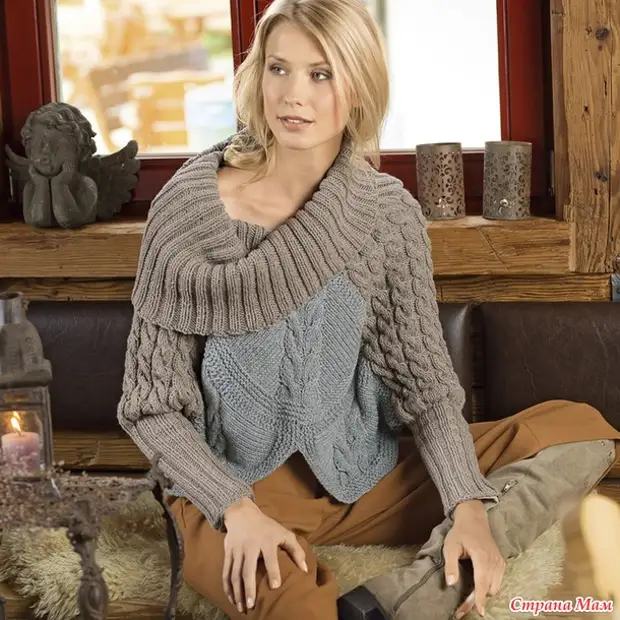
Dimensions
38/40.
You will need
Yarn (40% of merino wool, 30% viscose, 20% polyamide, 10% cashmere; 90 m / 50 g) - 400 g beige and 200 g sulfur; Spokes number 5; Circular spokes number 5.
Patterns and schemes
Tweetting
Facial and invalid rows are facial loops.
Romb A.
Score 63 loops on the knitting needles and link 1 outproteled series; This series is not taken into account in subsequent indications of the number of rows.
Continue the work of Sogl. Scheme 1. On it given 1st half of the rhombus from the middle loop. The 2nd half is supplemented in the mirror image, to do this, read the loop of the circuit without the middle loop from left to right, while instead of the loop instead of the loops together with the slope to go to the left 2 loops together face and for "braids" constantly cross 6 loops left.
The diagram is given face rows. In the wrong rows, all the loops are lying in the drawing or combined. instructions.
Through 60 rows from the initial row, the remaining 3 loops to lie, as 1 loop with a double slope to the left, trim the thread and stretch through the last loop.
Rhombus B.
Knit like rhombus A, but after 52 rows from the initial row, the remaining 11 p., As invalid.
Pattern of "Kos"
The number of loops is multiple 8 + 2 edges = knit combed. Scheme 2. There are facial rows on it. In the wrong rows, all loops are lying in the drawing.
Between the edge constantly repeat the rapport. Constantly repeating the 1-8th rows.
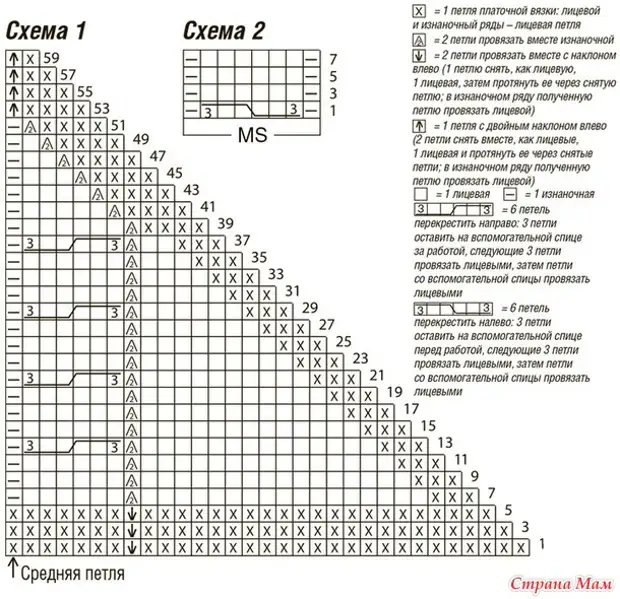
Rubber
Rows in the forward and reverse direction (the number of loops is multiple 4 + 2 edges). Edge, * 1 Pour, 2 facial, 1 Pour, from * to repeat, edge.
Circular rows (number loops are multiple 4): Alternately 2 facial, 2 irons.
Flat seams
The outer loop of the risms of rhombuses after the facial and irons form a visible "nodule". For the seam, connect the knots of the combined edges to the stammet-mixing seam of the jack.
If the "knot" edge coincides with the initial side, to connect the junction 1 of the nodule with 1 of the initial row loop, respectively.
In the coincidence of the initial rows in the middle of the transfer of the label of the initial rows to the stimplex seam of jack.
Knitting density
Rhombus a - width 33 cm, height 27.5 cm;
rhmb b - width 33 cm, height 25.5 cm;
21 p. X 22,5 r. = 10 x 10 cm, associated with a pattern from "Kos" (measured in a slightly stretched form);
19 p. X 23 r. / Circle. R. = 10 x 10 cm, connected with rubber band (measured in a slightly stretched form).
Attention!
Dimensions of rhombuses were obtained when measuring the model.
Sleeves knit from top to bottom. Arrow on the pattern = direction of knitting.
Pattern
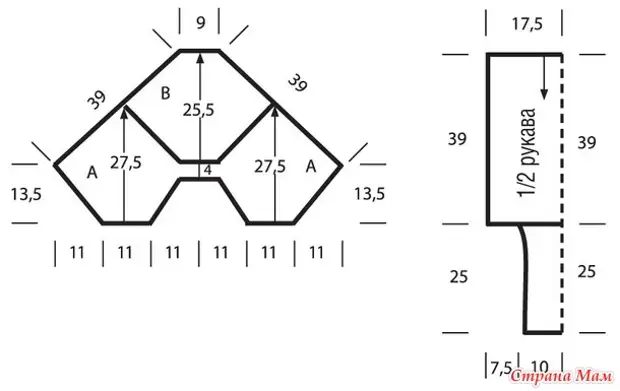
Completing of the work
Back
Perform 2 rhombus a and 1 rhombus b gray thread; Arrows on the pattern = direction of knitting. Details sew to sew. Pattern, performing flat seams.
Before
Knit as a back.
Sleeve
Beige thread to dial 74 loops and knit the pattern from the "brass", while the edges are also shattered only with a handful viscous.
Through 39 cm = in the 88th row from the initial row (= invalid row) to check on each "spit" of the 2nd + 3rd loop and the 4th + 5th loop together with an invalid = 38 p.
Continue work with rubber band.
After 25 cm = 58 rows from the beginning of knitting the plank, close all loops in the figure.
Assembly
The edges with the "braids" of the sleeves and the beveled side edges of the back and transfer to 39 cm flat seams.
Due to the different number of rows at the edges of the sleeves, more nodules than on the edges of rhombuses. Therefore, when performing seams, skip about every 4th nodule of the edge of the sleeves.
Sleeve plane seams also perform as flat seams.
Beige thread to gain on circular spokes along the edge of the neck 152 loop and for a postponed collar tie 30 cm with rubber band with circular rows. Then freely close the loops in the drawing.
2.
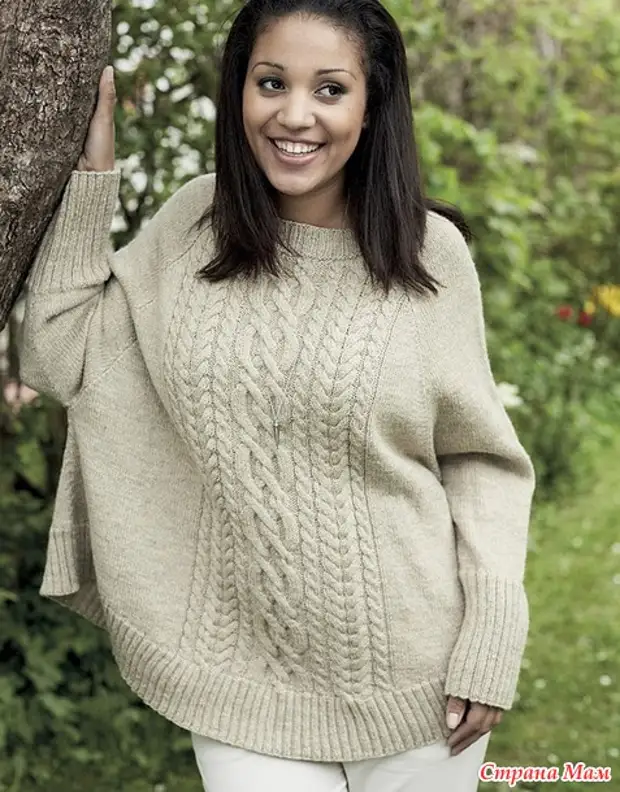
Dimensions
Plus S / M (m / l) L / XL
You will need
Yarn (100% wool; 50 g / 104 m) - 21 (23) 25 motors light beige; Spokes number 4 and 4.5; Circular spokes No. 4 40 cm long.
Patterns and schemes
Pattern "braids"
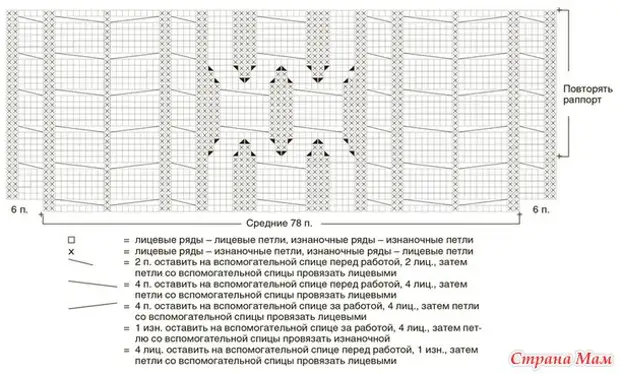
Knitting density
22 p. X 32 r. = 10 x 10 cm, connected with facial stroke spokes No. 4.5.
Attention!
Knitting density must match the specified! Therefore, before proceeding to work, the pattern of the pattern should be connected: dial 36 p. And knit 14 cm facial stroke.
Then count the loops on the middle section of the manufactured sample with a length of 10 cm: if there are more 22 loops on this segment, change the needles to thicker, if less - to thinner. The main thing is that the density of your knitting corresponds to the specified density in width.
The product knit on the same spokes as the sample. If only one number is specified in the instructions, then it applies to all sizes.
Completing of the work
Back
On the spokes number 4,5 to dial 78 p. And knit the pattern according to the diagram (1st row = ez. Row), at the end of each row to type 2 (3) 4 times 6 p. The first dialed 6 p . On both sides, turn on in the pattern, on the rest of the scored loops knit facechair.
After the last dialed 6 p. Continue to dial on both sides at the end of each row of 4 pp - only 14 times = 214 (226) 240 p.
Through 3 p. After the last row with scored loops in the following persons. A row to start dignifying the loops: 1 persons., 2 p. Snap together face, tie to the last 3 p. on the needle, 1 p. Remove the next loop to penetrate the face and removed the loop to stretch through the past, 1 individuals. These accurates repeat in every 4th p. (= In every 2nd faces. Row) - Total to perform 11 rows with rougops.
Tie 3 p. After the last row with grazers and mark the start of the Proucy.
Continue to knit with plans, but now in every 2nd p. (= Each persons. Row).
Important!
In the pattern to perform the drawing in the drawing. When 64 (68) 72 p., Loops close.
Before
Knit, as a back, but at the same time eliminate the neck: when there will be 82 (86) 90 p., Continue to carry out the regulated accurates, close the average 30 (34) 38 p. And both sides finish separately.
To round the neck close from the inside edge at the beginning of each row
4 times 4 p. (Continuing to carry out the regulated rebalance!), Then close the remaining loops in one row.
Right sleeves
On the spokes number 4, dial 86 (94) 102 p. And knit with a rubber band (= alternately 2 is elevated., 2 persons., 1st row = out. Row). When 16 cm of gum will be connected, continue to work with facial stroke spokes No. 4.5.
Important!
In the 1st p. Evenly reduce the loops so that on the spokes it was 76 (84) 92 p.
After 4 r. After the rubber band, add 1 p. (after / before the edge loops) in each 4th p. - only 10 times = 96 (104) 112 p.
Tie 3 p. After the last additives, note the beginning of the Proucy and start the regulated subsurface: 1 persons., 2 p. Slice together, tie to the last 3 p. On the needle, 1 p. Remove the next loop to penetrate the front and removed loop to stretch through the past, 1 individuals.
Perform the regulated accommodation in each 4th p. (= In every 2nd faces. Row).
When it remains 34 p. And 1 p is connected. After the last row with the planers, close for the bevel at the beginning of each individuals. A series (continuing the regulated accurate at the end of the row!) 4 times 6 p., The remaining loops close in one row.
Left sleeve
Knit, as right, but the upper beep - in the mirror image.
Assembly
Seam details on the front side by mattress and knitted seams = mattress - longitudinal edges of parts (= 1 r. X 1 r.), Knitted seam - edges with closed loops.
Run the regulated seams by starting the TRUMY marks.
Perform side seams and seams of sleeves.
Lower Planck
On Circular Spokes No. 4 to dial the product on the lower edge of the product with the front side of the loop: start from the right side seam and typing 1 n. From each loop type-dialed + 1 additional loop for each 2nd loop (the number of loops should be multiple 4 p. ).
Knit in a circle with a rubber band (= alternately 2 persons., 2 out.) Approximately 9 cm, then loops close.
Baika neck
On Circular Spokes No. 4 to dial the loop on the edge of the face with the front side of the hinge: start from the right plane seam on the back and recruit 1 p. From each closed loop throughout the edge of the neck.
Slit in a circle of 1 r. Facial, uniformly lubbing the loop so that there were 132 (140) 148 p. Then knit: 1 p. Pouring, 1 r. Facial and then continue to work with a rubber band (= alternately 2 persons., 2 зан.).
When the width of the baker will be 4 cm, loops close.
3.
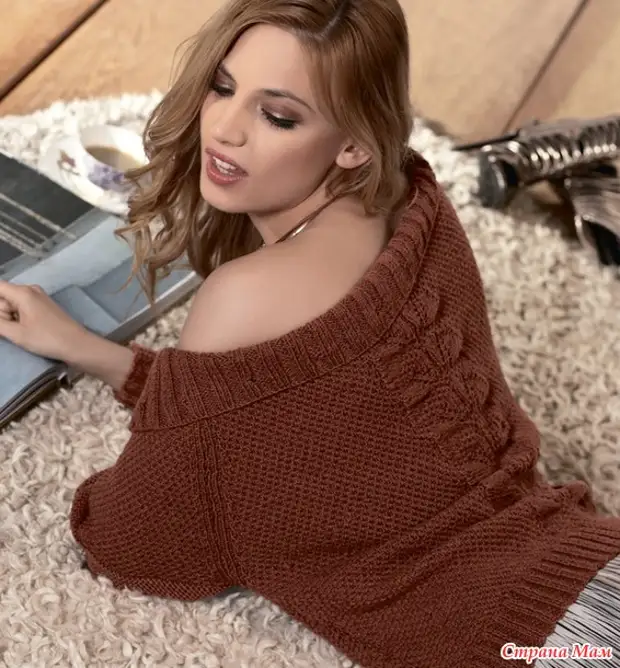
Dimensions
36/38 (40/42) 44/46 (48/50)
You will need
Yarn (100% camel wool; approx. 100 m / 50 g) - approx. 650 (700) 750 (800) g red; Spokes number 3 and 4; circular spokes number 3; 200 (200) 220 (220) cm of a red satin braid 3 mm width.
Patterns and schemes
Facial smooth
Facial rows - facial loops, invalible rows - invalous loops.
In the circular rows, all the loops are lying face.
Painted smooth
Facial rows - invalous loops, invalible rows - facial loops.
In the circular rows, all the loops are tied with involnery.
Rubber A.
Alternately 2 facial, 2 wrong.
Rubber B.
Alternately 3 facial, 3 wrong.
Structural pattern
Knit on an even number of loops:
1st row: chrom., * 1 facial, 1 p. Remove, as with an invalible knitting (thread before work), from * repeat, chr.
2nd + 4th rows: between chrome. knit outpan loops.
3rd row: krom., * 1 p. Remove, as with an outfit knitting (thread before working), 1 facial, from * repeating, chrome.
Height to repeat from the 1st to the 4th row.
Pattern "Leaf"
In the width of 28 p. Schemes of 1 x. In the height of the 1-4th row of performing 1 x
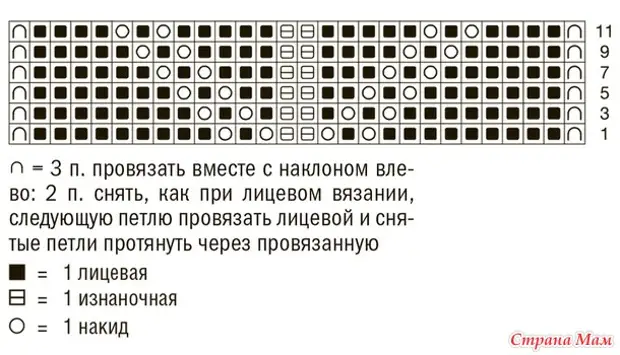
Important!
The "leaves" pattern is performed on the back.
Sequence of patterns
10 (12) 14 (16) p. structural pattern
12 p. Pattern "Leaflets", 8 (10) 12 (14) p. structural pattern
12 p. Pattern "Leaf", * 8 (8-10-10) p. structural pattern
12 p. Pattern "Leaflets", from * Repeat another 4 x, finish 18 (22) 24 (28) p. structural pattern = 160 (168) 184 (192) series.
Cross ribbed pattern
8 r. izn. stroit
3 r. facial stroy
8 r. izn. stroits (start from the wrong row and finish the facial nearby),
3 r. facial stroy (start and finish 1 purlby)
8 r. Pouring stroit, 2 r. facechair = 32 r.
Decorative revenues
On the right edge: krom., 2 p. Facial stroit, 2 p. Slit together with a slope to the left (= 1 p. Remove, as in front of knitting, the next loop to penetrate the front and removed loop to stretch through the awaited);
On the left edge: 2 p. Slit together with the slope to the left, 2 p. Facial stroit, com.
Double loop
After turning at the beginning of a row, the thread lay before work, to enter the spite to the right in the 1st p., I will remove the loop with the thread. Then thread strongly pull back = double loop. In the next row, both parts of the double loop to lie as one in the drawing - facial or invalid.
Knitting density
24 p. X 37 p. = 10 x 10 cm, connected by the structural pattern or pattern of "leaves";
24 p. X 30 r. = 10 x 10 cm, is associated with a cross-ribbed pattern.
Both samples are associated with Spokes No. 4.
Pattern
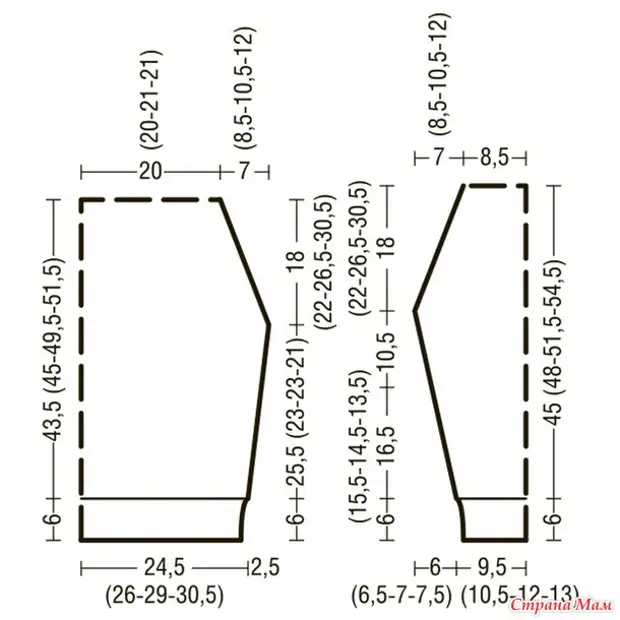
Completing of the work
Before
On the spokes number 3, dial 118 (126) 138 (146) loops and tie for the bottom line 6 cm = 20 p. Rubber A, while in the 1st faces. Row after chrome. Start with 1 is elegant. loops.
Continue work with structural pattern of spokes No. 4.
For side beeps, add on both sides of the drawing in each 14th p. from the bottom plank 6 times (in each 14th r. 3 times and in each 12th p. 3 times) in each 14th p. 3 times and in every 12th p. 3 times (in each 12th r. 5 times and in the next 10th p. 1 s) for 1 p. = 130 (138) 150 (158) p.
For plans of the bevels in 25.5 (23) 23 (21) CM = 94 (86) 86 (78) p. From the bottom plank, it is reduced from both sides of 1 x 1 p., then in each 4th p. Another 16 (20) 24 (28) x is 1 p. (See above decorative rebukes) = 96 (96) 100 (100) p.
After 18 (22) 26.5 (30.5) cm = 66 (82) 98 (114) p. From the beginning of the regulated beeps, the remaining loops of the neck temporarily leave.
Back
Knit, as before, but after the bottom plank on the average 28 p. Perform patterns in the above sequence.
Sleeve
On the spokes number 3, dial 42 (46) 50 (54) loops and tie for a strip 6 cm = 20 p. Rubber A, while in the 1st faces. Row after chrome. Start with 1 is elegant. loops, and in the latter. Row, evenly distributed, add 4 (6) 8 (10) p. = 46 (52) 58 (64) p.
Continue work with structural pattern of spokes No. 4.
For the bevels, add on both sides after the 6th r. Gum 1 x 1 p., Then in each 6th p. Another 12 (8) 4 (0) x is 1 p., added loops include in the pattern.
At the same time after 16.5 (15.5) 14.5 (13.5) cm = 62 (58) 54 (50) n. From the gum knit with a cross-ribbed pattern = 76 (84) 92 (100) p.
After 10.5 cm = 32 p. From the beginning of the transverse ribbed pattern, again continue working with a structural pattern.
At the same time, perform the plans of the squeaks, as on the fore, while starting with the 1st grain in the 1st row = 42 p.
After 18 (22) 26.5 (30.5) cm = 66 (82) 98 (114) p. From the beginning of the regulated beeps of the loops temporarily leave.
Assembly
Run the plane seams, side seams and seams of sleeves.
On the right sleeve, the average 12 p. Left loops of all parts to translate into circular needles, starting with 12 marked loops of the right sleeves = 276 (276) 284 (284) n. On all hinges knit circular rows of rubber band in the collar bar, continuing tags Both sides of the average 12 loops.
After 9 r. From the beginning of the collar, continue to work with shortened rows (after the 9th r. Turn the work): Double loop, 1 is elegant. A number of up to 12 marked loops and these 12 p. To temporarily leave, for this, before marked loops, turn and perform a double loop.
After that, another 16 x at the end of each of the next row 15 p. Leave the same = 24 p.
After the latter is. A series to turn, make a new mark on the beginning of the circular row and from the label to knit on all hinges with circular rows.
Run 5 circle. r., At the same time in the 1st round. R. Double loops to stick around the drawing together with the next, respectively, the previous loop.
After that loop closed in the picture.
Skip the satin braid through the holes of the 1st row of the collar-plank = start and finish at a distance of 10 cm from the middle of the pass ("stitches" lay on the front side on top of the front tracks).
Using the braid, you can adjust the depth of the cutout.

